Rocket Tank "Object 287"
In February 1961, the USSR Council of Ministers ordered the development of a new project of a promising rocket tank. The overall coordination of the work and the design of some of the important elements of this machine was entrusted to the design office of the Leningrad Kirov Plant under the direction of J. Ya. Kotin. The guided missile for the tank should have been created by OK A-16. Nudelman. The development of a weapon stabilization system was entrusted to TsNII-173, and TsKIB and GSKB-47 were responsible for creating artillery weapons and ammunition.
The project of the new rocket tank received the factory designation "Object 287". Part of the design work was completed by the end of 1961, and at the beginning of the next 1962, the preliminary design was presented to the customer. The following months were spent on preparing the required technical documentation. In the same year, 1962, the authors of the project received permission for the construction and testing of experimental machines of a new type.
Having studied the requirements of the customer and the available opportunities, the authors of the project proposed the original look of a combat vehicle on a tank chassis. By some processing of one of the existing medium tanks, it was proposed to build a combat vehicle with powerful anti-bullet armor and combined armament. To fight the enemy’s armored vehicles, the promising 287 Object was supposed to use both guided missiles and small-caliber guns. The specific complex of weapons had a noticeable effect on the appearance of the fighting compartment.
Initially, the project involved the use of an anti-tank complex with an 301-P missile. This product caliber 140 mm accelerated to 250 m / s and carried a cumulative warhead. Used radio command control system. The rocket launcher at the time of the shooting was to be advanced outside the tower. The missile complex was proposed to supplement with a pair of 23-mm automatic guns in their own domes on the sides of the tower.
The construction of two prototypes with such an armament composition began in the 1962 year and continued until the spring of the 1964. Next, two prototypes went to the factory tests and showed their potential. It turned out that the missile and cannon armament of the prospective tank did not fully meet the requirements. The missile showed insufficient characteristics, and the guns did not allow it to be strengthened in the context of fighting armored vehicles.
According to the results of factory tests, the “287 Object” was significantly reworked. Instead of the 301-P missile, they proposed using a more sophisticated ammunition complex "Typhoon". Automatic guns should be replaced more powerful weapons larger caliber. Soon, LKZ and joint venture employees formed a new image of the rocket tank. It is in this form that the “287 Object” remained in stories.
In both versions of the project, the tracked chassis of the medium tank “Object 432” (T-64) recently developed by Kharkov specialists was proposed as the basis for the new rocket tank. The developers of the “Object 287” project used the maximum possible number of ready-made components and in fact rebuilt only the combat compartment of the existing armored vehicle. Enclosure with protection, power plant, etc. remained the same. The layout of the internal volumes also did not undergo major changes: in the front part of the corps there was a control compartment with the places of the driver and commander, in the center - the fighting compartment, in the stern - the power plant.
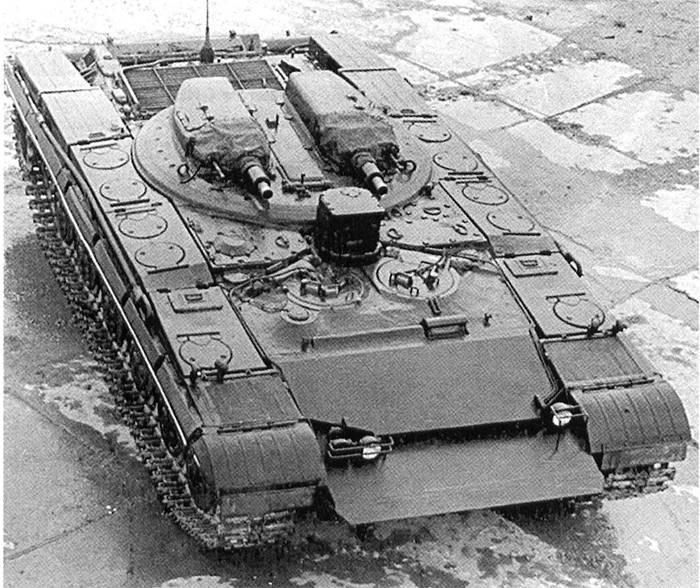
View from above. Photo Btvt.narod.ru
In the “Object 287” project, a ready-made armored body was used, which was distinguished by high levels of protection. Thus, the frontal part of the hull was a combined barrier in the form of an 90-mm steel sheet, a pair of fiberglass blocks with a thickness of 130 mm, and armor parts with a thickness of 15 and 30 mm. When installed at an angle 70 ° to the vertical, such a reservation protected the vehicle from all existing armor-piercing shells and foreign-made cumulative ammunition.
The hull sides had homogeneous reservations 20-56 mm thick; their sheets were set with a slight slope. Similar protection had feed. The roof of the case was made of 20-mm sheet. The body’s own armor was complemented by mounted side screens, which increased the tank’s resistance to cumulative ammunition.
The new project proposed to abandon the standard tank tower in favor of the new device. The roof aperture was covered with a low, curved dome of a small height. Along its longitudinal axis was a long hatch for taking the rocket out. On the sides of this hatch was a pair of small turrets with artillery weapons. Turretcaps rigidly mounted on the dome and could only move with it.
At the rear of the hull, a two-stroke 5TDF diesel engine with an 700 hp power should be installed. The motor was connected to a pair of seven-speed side gearboxes. Torque output to the rear drive wheels with pinching engagement. As in the case of the base tank "Object 432" / T-34, the engine compartment of the missile armored vehicles differed in the minimum possible size. There were several fuel tanks inside and outside the hull. Under the protection of armor were 700 liters of fuel, outside the case - 350 liters. The engine mated with a SG-10 starter-generator with power up to 10 kW.
The undercarriage of the rocket tank consisted of six small-diameter road wheels on each side. The rollers were mounted on an individual torsion bar suspension. The first, second and sixth rink of each side also had a shock absorber. In front of the hull were placed the guide wheels in the stern - leading. Together with the finished chassis borrowed four pairs of supporting rollers. A caterpillar with a rubber-type hinge of a parallel type was used.
Under the lower frontal part of the case, the self-digging equipment dump was hung. In case of crossing water obstacles on the bottom of the rocket tank was equipped with equipment for underwater driving. His pipes in the stowed position were fixed at the stern of the hull.
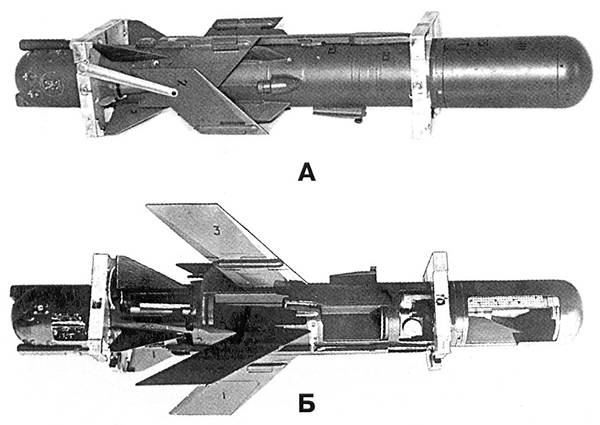
Rocket 9М11 complex "Typhoon". At the top (A) - the rocket is in the transport position, at the bottom (B) - the split rocket model in the flight configuration. Photo Btvt.narod.ru
In front of the hull were placed jobs of two crew members. On the left was the driver, on the right - the commander. Both places were equipped with their own hatches in the roof and viewing devices. The inhabited compartment was completed with a collective system of protection against weapons of mass destruction. In its composition were present the device of radiation and chemical reconnaissance, as well as the filtering unit.
Behind the hatches of the crew, on the longitudinal axis of the hull, fit the panoramic sight, necessary for the use of all existing weapons. Inside the rotary armored body with front curtains placed optical equipment. Combined sight 9Sh19 "Sapphire" allowed to observe at any time of the day and did not require infrared illumination. The field of view of the sight was stabilized in two planes. Line of aiming performed independent. The daylight observation range was virtually unlimited. At night, the 9Sh19 device allowed monitoring the situation at distances of no more than 900-1200 m.
At the driver’s workplace, the Klin night vision device developed by the Zagorsk Optical-Mechanical Plant was installed. Curiously, this device was created specifically for a promising rocket tank.
The “287 Object” received an uninhabited fighting compartment with remote control systems. All weapons were placed under the flat dome of the tower and controlled from the workplace of the commander-operator. Depending on the type of target, the commander could fire using guided missiles, two cannons, or a pair of machine guns. The hoisting of all tower armament was carried out with the help of several mechanical drives. Horizontal targeting of barrel and rocket weapons was carried out synchronously, within a sector of width 200 °. Vertical - separately for the launcher and receiver systems.
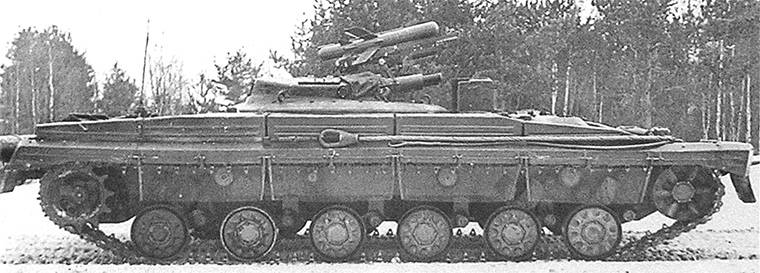
The "287 Object" is preparing for a shot. Missile launcher withdrawn in a firing position. Photo 477768.livejournal.com
The equipment of the anti-tank missile complex 9K11 "Typhoon" with 9М11 missiles was located in the center of the fighting compartment. Directly under the dome of the tower, under the opening hatch, was a mobile launcher. Before the shot, she had to lift the rocket and take it out of the hull. After the shot, the guide was returned inside the tank for reloading. Most of the fighting compartment was given under the mechanized laying of missiles. It managed to fit the 15 9М11 products, as well as the means to feed them to the launcher during reloading. In laying the rocket was placed tail forward along the direction of the tank. When lifting the launcher rotated around a horizontal axis.
The missile complex "Typhoon" was a rocket with radio-command guidance. The rocket received a cylindrical body with a diameter of 140 mm, as well as a set of folding wings and X-shaped rudders. The head of the rocket was given under the cumulative fragmentation warhead. It punched up 500 mm of homogeneous armor and formed a field of shards, equivalent to a 100-mm high-explosive projectile. The solid propellant engine accelerated the rocket to speeds of the order of 250 m / s and allowed to attack targets at distances from 500 m to 4 km.
When using the Typhoon system, the commander-operator, using the existing panoramic sight, had to follow the target and the rocket. Guidance missiles carried out manually with the transfer of commands over the air. No automation tools were used.
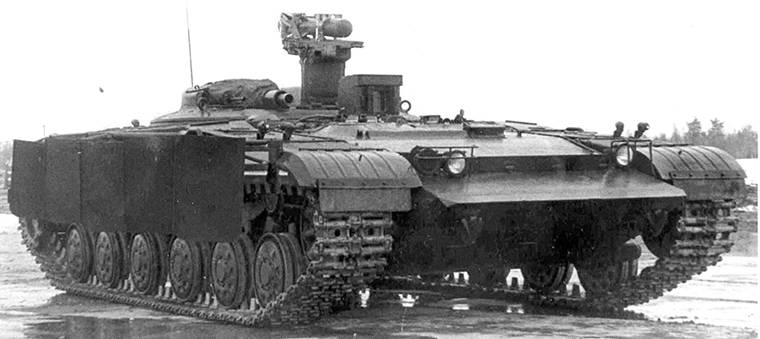
Missile tank with side screens installed. Photo 477768.livejournal.com
To attack the enemy's armored vehicles, the 287 Object could also use two semi-automatic guns. Two smooth-bore 2А25 "Lightning" guns with 73 mm caliber were placed in the turrets on the dome of the combat compartment. The guns were equipped with automatic loaders with drum type packings. The ammunition of one gun consisted of 16 active-jet shots PG-15В. Similar ammunition was used by the Thunder 2А28 and the Lance LNG-9 grenade launcher. The cumulative PG-15В projectile was sent to a range of no more than 700-1000 m and punched up to 300 mm of homogeneous armor.
With two semi-automatic guns, two rifle-caliber machine guns were paired. According to the available data, initially the “287 Object” was planned to be equipped with TKB-015 machine guns by the designer G.I. Nikitin, but later they were replaced by serial PCT. However, such a refinement of the weapons complex did not have a significant impact on the combat qualities of the equipment. Ammunition of two machine guns consisted of 2 thousand rounds.
The barreled weapon, as well as the missile system, was to be controlled remotely, from the workplace of the commander. The search for targets and the guidance of weapons was carried out using the combined sight 9Sh19. On command from the remote weapons opened fire. Like the Typhoon 9K11 system, the 2А25 guns and PKT machine guns worked independently, without human intervention.
Based on the aggregates of the existing tank, the 287 Object armored vehicle differed in size and slightly reduced mass. The length of the rocket tank was 6,12 m, width - 3,42 m. The refusal of the traditional tower in favor of the new low-profile design with two small turrets reduced the height of the tank to 1,75 m with the clearance of 450 mm. Combat weight was 36,5 t.
High power density allowed to maintain the driving characteristics at the level of the base medium tank. Rocket "Object 287" could reach speeds up to 66 km / h and take place on one refueling to 500 km. Overcoming various obstacles was provided. Water barriers crossed along the bottom, with the help of OPVT.
In the 1962-64, the Leningrad Kirovsky Plant built a pair of prototype “Object 287” tanks of the first configuration, using 301-P missiles and small-caliber guns. In May, the 1965 of the year began assembling two other machines of the new look, completed with the Typhoon missile system and Lightning guns. There is reason to believe that these prototypes were rebuilt from existing prototypes. In accordance with the new solutions, two prototypes and one building with a turret for testing should be submitted for testing.
From 1965 to 1968, two experienced 287 Object missile tanks were on trial and demonstrated their capabilities. It was found that the machines in the existing configuration have both strengths and weaknesses. The undoubted advantage was the presence of several weapons systems of various kinds, which made it possible to attack different targets using the most effective weapons. Effective panoramic sight gave certain advantages.
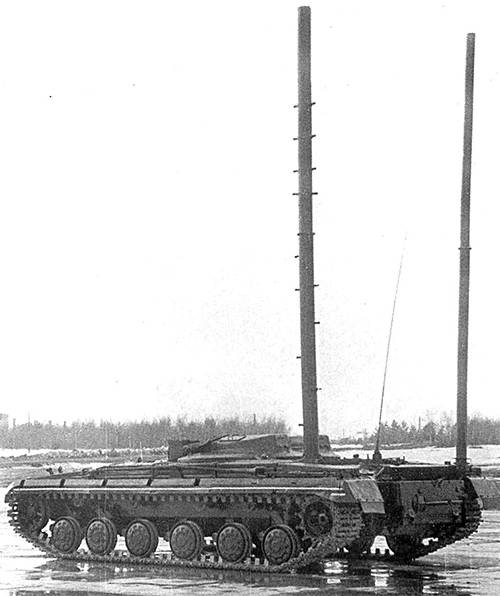
Rocket tank with installed equipment for underwater driving. Photo Btvt.narod.ru
In the control system of the complex 9K11 "Typhoon" there were no automation tools, which seriously hampered the work of the commander and reduced the effectiveness of the shooting. Tests have shown that problems with manual guidance do not allow to obtain a decisive advantage over tanks of a potential enemy at ranges up to 2 km. At long distances, the advantage was provided only by the missile's range.
The 2А25 “Lightning” semi-automatic guns did not show the desired range and accuracy of the fire. Aerodynamic stabilization shells could pierce the declared 300 mm of armor, but the probability of hitting a typical target was insufficient. Machine guns, in turn, showed the desired results, but the enemy's living force was not the priority target of the rocket tank.
There have been problems with the new optical equipment. So, the Sapphire sight required refinement and turned out to be quite difficult to operate. The driver’s night vision device was also not perfect. It turned out that he has a large inertia image. This virtually excluded the possibility of driving a car at night at high speeds.
In terms of technical and combat characteristics, the new 287 Object missile tank was of no interest to the armed forces. To eliminate the identified deficiencies, it was necessary to recycle the mass of components and assemblies, and in some cases it might be necessary to replace some equipment with new samples. A similar refinement of the existing armored vehicles was considered inexpedient.
3 September 1968, the Council of Ministers decided to stop all work on the new rocket tank due to the availability of more successful alternatives. Instead, it adopted a more successful "Object 150" or IT-1 "Dragon". In this case, the leadership has determined the future development of military equipment. The theme of guided missile armament for tanks was now proposed to be developed within the framework of the 434 Object project. The future medium / main tank T-64А was supposed to receive the Cobra 9K112 guided weapon system. A few years later, this project was successfully implemented, and a new type of rocket was brought to operation in the army.
To test the project "Object 287" were built two experienced rocket tanks and one building. From the available information it follows that the latter was destroyed during the shelling tests. After completion of the tests and the closure of the project, one of the fully-equipped experimental tanks was decommissioned and disposed of. The second "287 Object" avoided this fate. Now he is on the exposition of the museum of armored vehicles in Kubinka.
During the sixties, the Soviet defense industry developed several versions of armored vehicles with guided missile anti-tank weapons. Several such projects ended with the construction of prototypes, and one even managed to get into service. "The 287 object" reached the test, but could not show itself in the best way, and therefore did not go into the series. In addition, by this time a new idea of creating a "universal" tank gun-launcher. In connection with the emergence of such weapons, the need to create specialized missile tanks disappeared.
Based on:
http://mbtvt.ru/
http://btvt.info/
http://dogswar.ru/
https://strangernn.livejournal.com/
Solyankin A. G., Pavlov M. V., Pavlov I. V., Zheltov I. G. Domestic armored vehicles. XX century. - M .: Exprint, 2010. - T. 3. 1946 – 1965
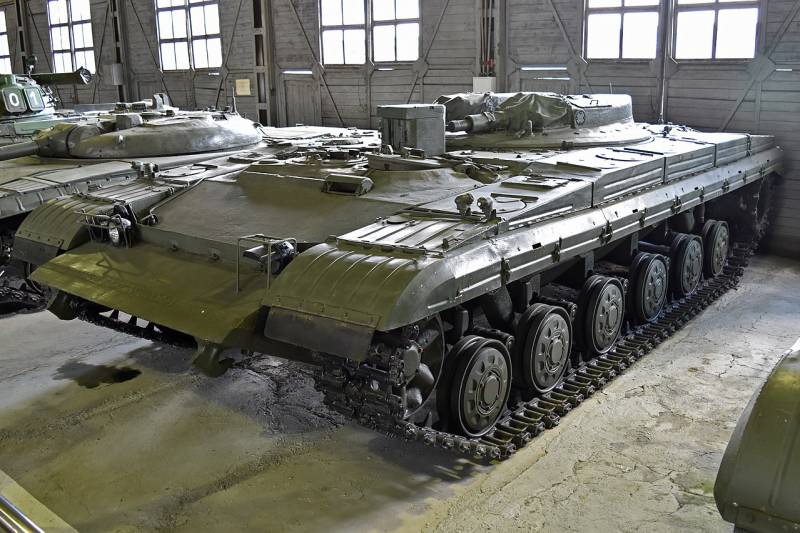
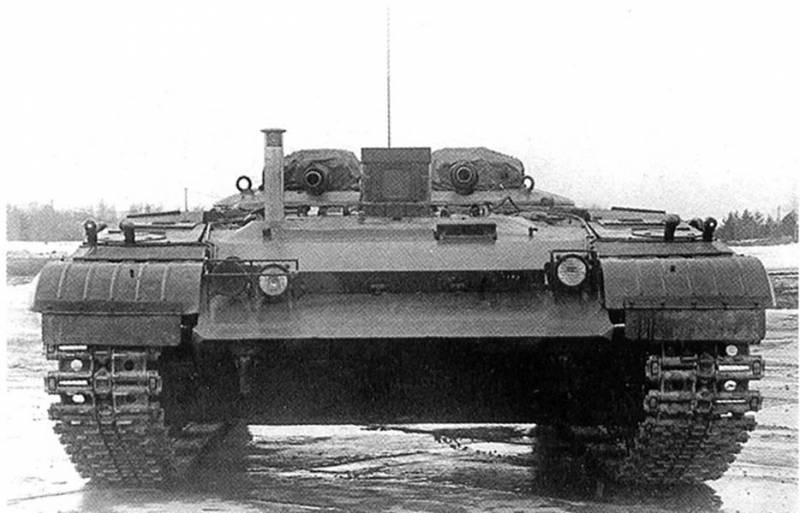
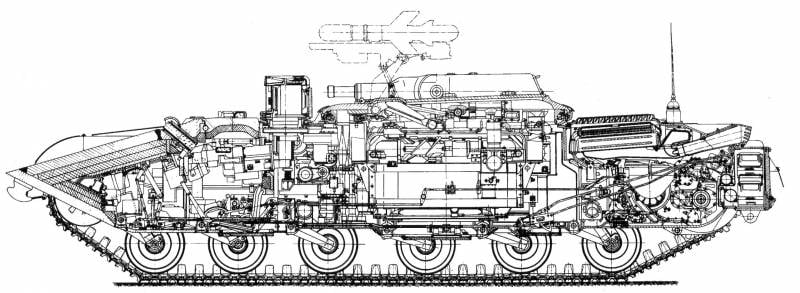
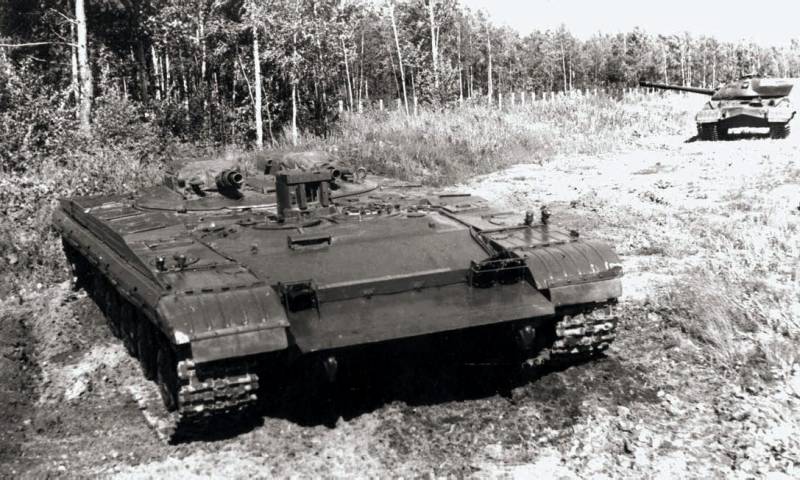
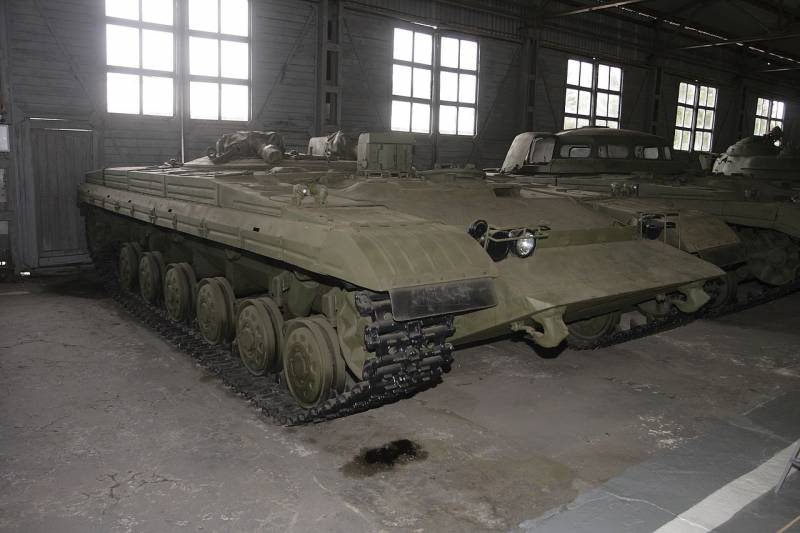
Information